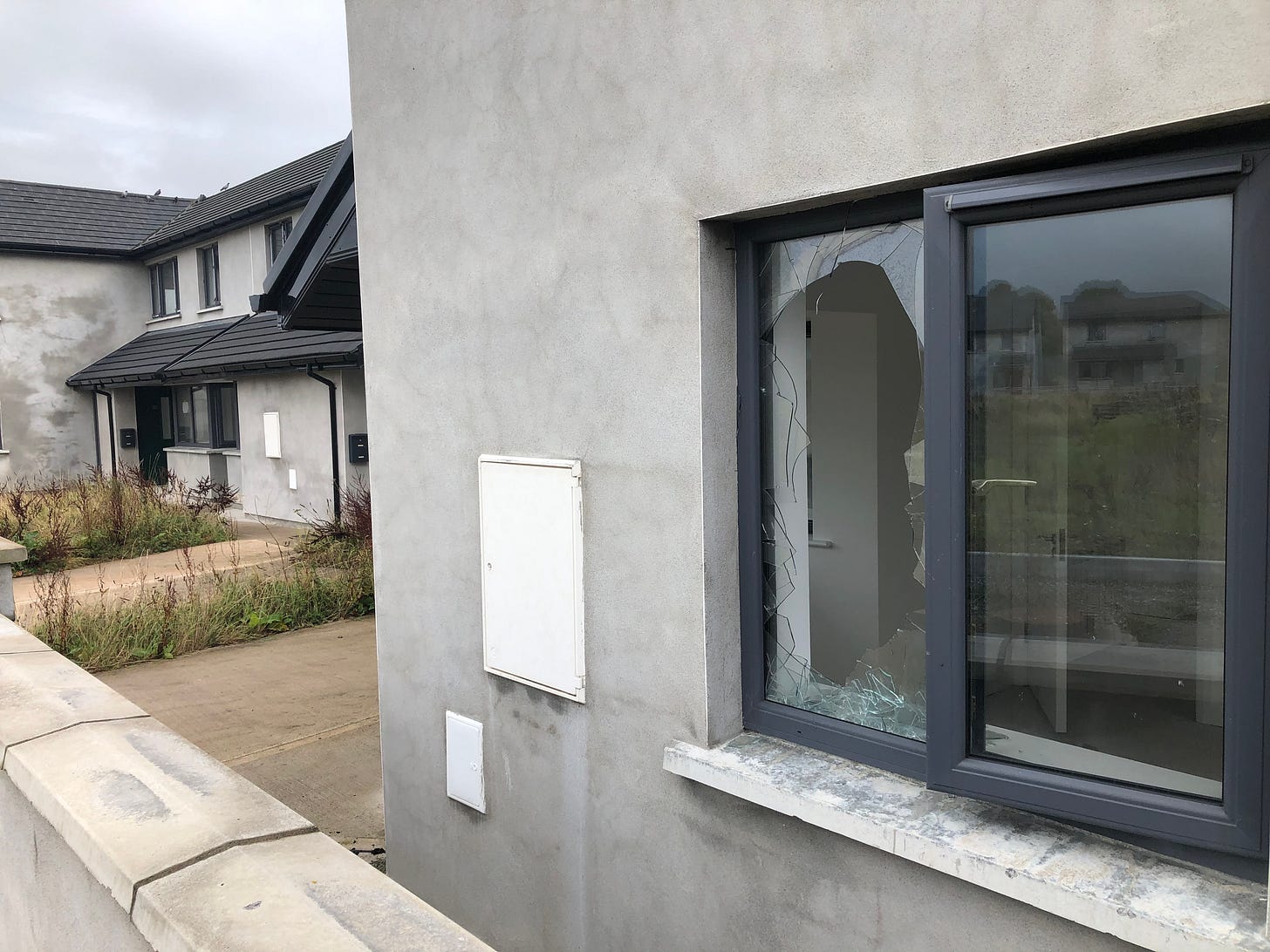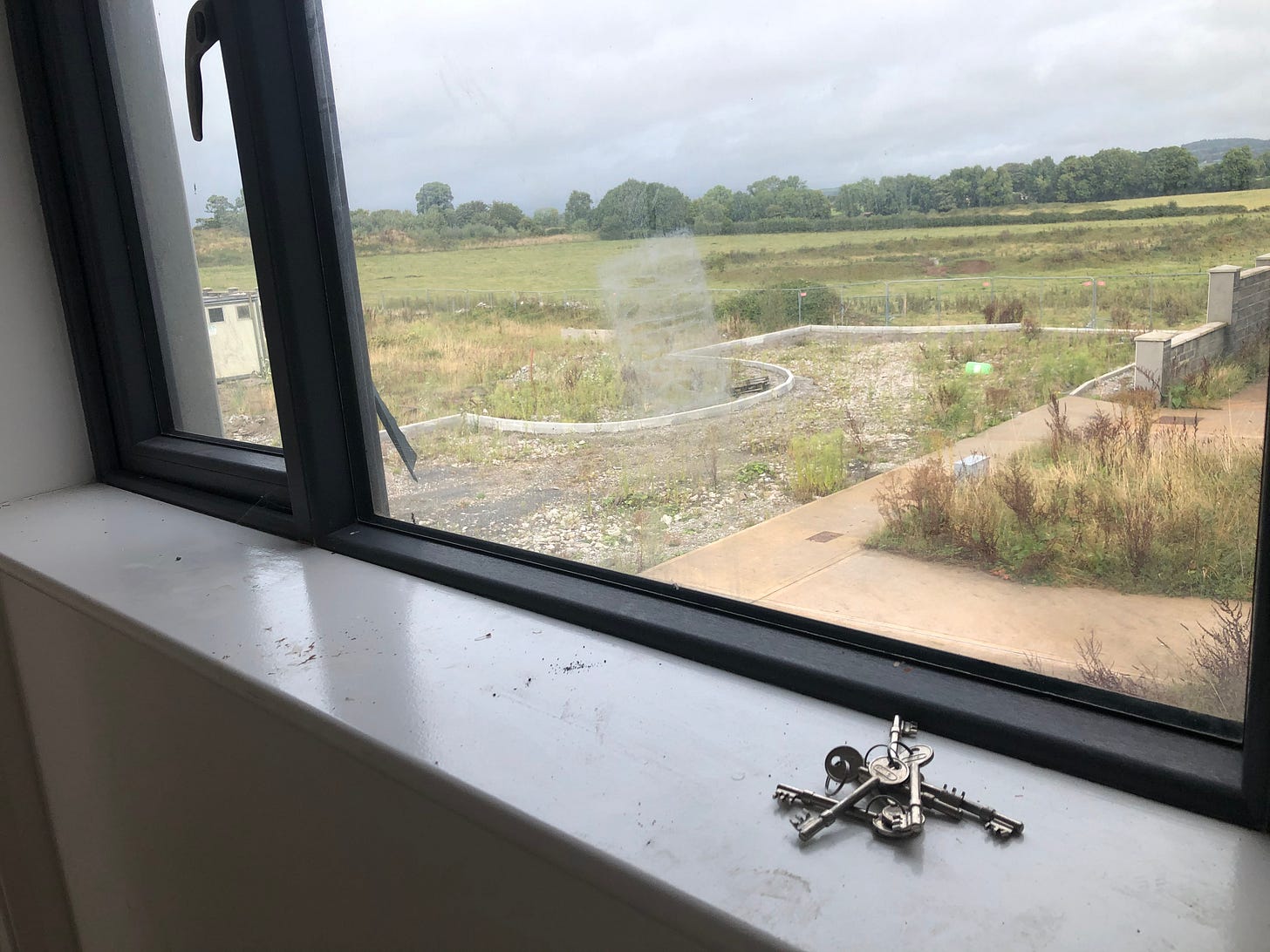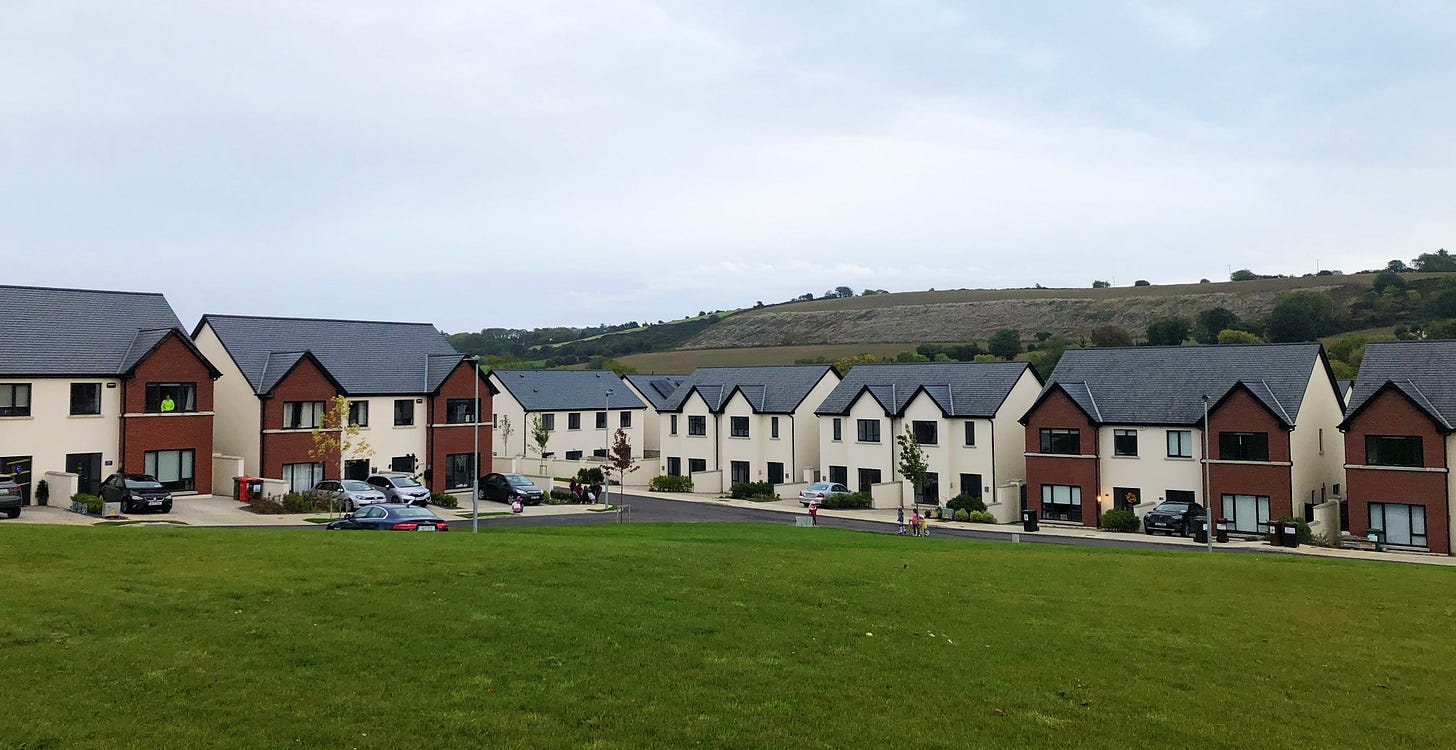Social housing: why so slow?
Delays of years in two Cork County Council social housing projects raise questions about how the urgency of tackling homelessness is perceived.
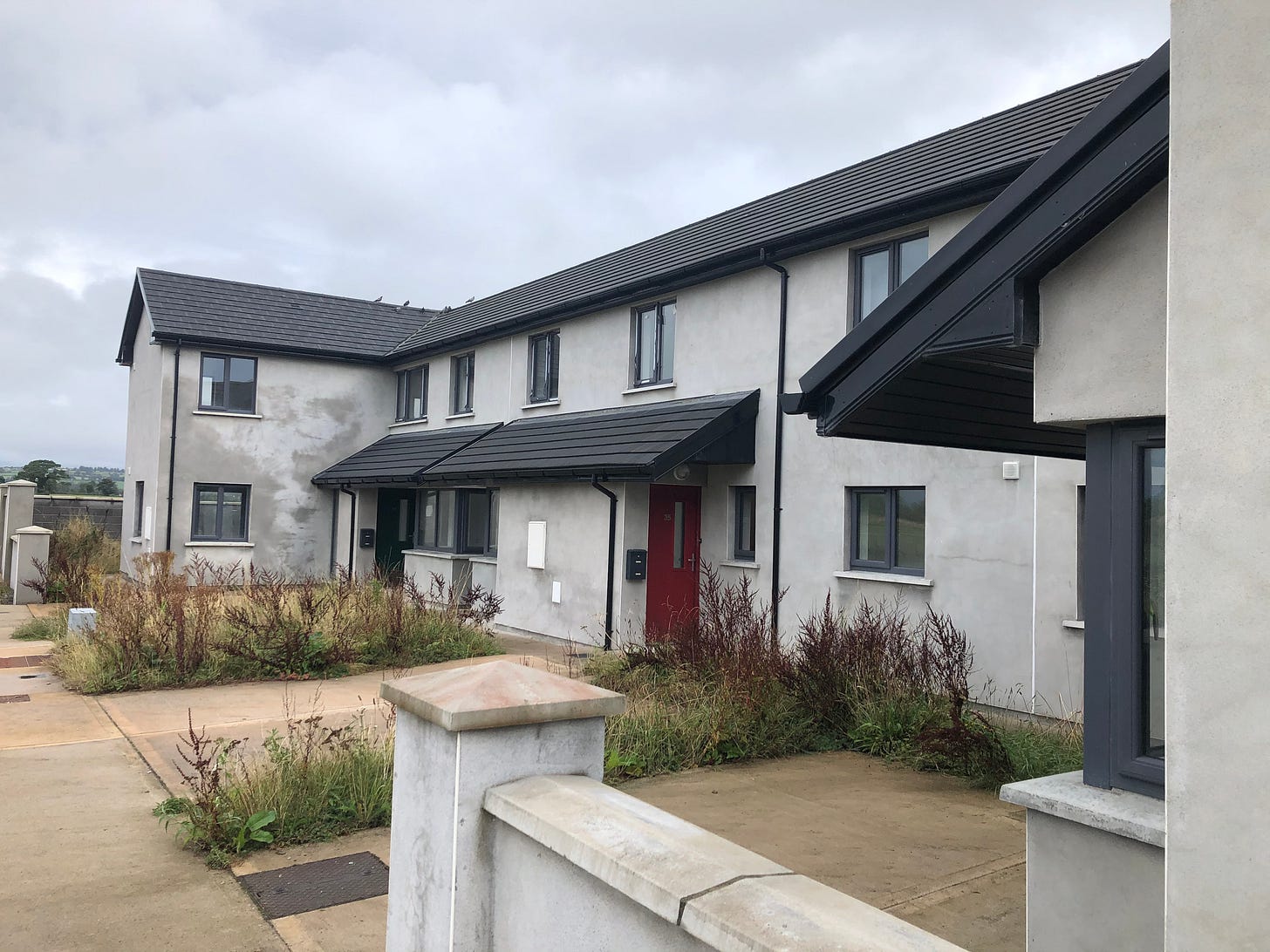
It’s a devastating sight: more so the houses nearing completion then those that are still just shells.
At Crann Árd estate in Fermoy, in what Cork County Council describes as an “area of high demand” for housing, 48 social housing units lie unfinished for two and a half years.
Some are weeks away from completion, builder Mike Lyons tells me. Phase 2, three houses at 34, 35 and 36 Beech Lawn, have power, fitted kitchens, state-of-the-art heat pumps: the only thing they’re missing is flooring, some paint and a sewage connection, and they could be someone’s home.
They have three bedrooms, with two bathrooms and a downstairs loo, and sliding french doors through to a nice sized back yard. It’s easy to imagine the sound of children happily playing here, dinners cooking, lives being lived.
Instead, they’re sitting empty while vandals move in. Windows are getting broken; the waste ground between the different houses is now littered with smashed sinks.

“Our biggest concern now is security,” Mike, who is the son of the founder of Michael M Lyons Building Contractors, says, standing and surveying the site. “It’s not our job to, and we can’t afford to be putting security guards in here; we put up the fencing, but they find a way through.”
Builder owed over €500,000
Mike’s company is owed over €500,000 by the site’s developer, Bothwell Developments. One outstanding sum, of €299,752, was first invoiced in November 2019, while another, for €276,222, was invoiced in June 2020, months after Mike’s firm had no choice but to down tools on the project.
“One issue was the cash flow; the council were paying the developer when houses were completed, but he was meant to be paying us every month for work that was done. He didn’t manage the cash flow. Really, it stopped in December 2019, but we stayed on site just not getting paid very much until March 2020.”
Michael M Lyons Building Contractors is based in Araglen, not far from Fermoy; one thing that has been particularly difficult for Mike has been knowing the housing situation in his own community while these houses remain unfinished for more than two and a half years.
“There were probably families around here that thought they were getting one of these two years ago,” he says. “That’s sickening.”
“We don’t want to leave this site: we’re committed to the project, 100%. But it’s the two parties that need to sort it out. We’ll finish the lot within nine months if they talk and come up with a solution because at the moment everyone is losing.”
Construction started on the Crann Árd development, which had already been beset by delays in in the planning process, in January 2019.
At the height of the construction, Mike says there could have been 50 workers on site at times. When the money stopped coming in, Mike focused on paying off his smaller suppliers and subcontractors first; many bigger companies agreed to defer payment. It sounds like an incredibly stressful situation to have faced, but Mike shrugs.
“I think we handled it well,” he says. “The bigger lads are happy to wait with us because they work with us all the time, and they took the pressure off by saying they could wait, but all the small local lads got paid. Every job we’ve done ever since, there’s no profit because we’re paying off the lads we owe money to.”
Dispute between developer and council
The “two parties” Mike is talking about are Cork County Council and Bothwell Developments. And this is where things get complicated and lengthy.
There are long-standing disputes between the developer and the local authority that seem to be based on the arrangements for a sewage pumping station; during the planning process, Irish Water had stated that 48 of the houses - the ones now incomplete - could not be connected to the existing sewage system.
I emailed Cork County Council to ask them for an update on Crann Árd and Cork County Council told me that they are not at liberty to discuss the situation because there are now legal proceedings underway.
It’s unknown who initiated these and what the case is built around, but the average length of time for a High Court case these days is two years and two months, according to the Law Society Gazette. Another two years of vacancy at Crann Árd and, as Mike Lyons puts it, “the council will have to pay a lot more in repairs. It will cost a lot more to get them finished.”
Mike points around at the houses in varying different states of completion. “Those three would be finished in about a month. Those seven would take six weeks, and there are nine over there that would be done in three months.”
To Mike, to get those houses finished and full of families, “there’s a simple solution. There’s X amount of work done, and that can be valued. The council can put in a mechanism to make sure we’re paid, and then when it’s completed, whatever balance is left over goes to the developer. The whole lot could be done in nine months.”
Meanwhile, there are 6,789 people on the housing list in Cork County.
There were 486 adults accessing emergency accommodation in Cork City and County this August, according to the government’s latest homelessness report.
Across the “South West” region, which is comprised of Cork and Kerry, there were 74 families in emergency accommodation: 111 adults and 146 children, with 47 of the families single parent families.
There were 1,234 new applications for social housing made to Cork County Council in 2021; 827 of these were housed, which means that after one year, 33% of applicants were not housed.
€83 million on housing in 2021
Cork County Council spent €83,443,455 on housing in 2021 according to a report presented at a council meeting in January 2022. In the first quarter of 2022, they had spent €20,219,447.
Urgent
It should go without saying: if you’re insecurely housed or in emergency accommodation, every single day counts.
Insecure accommodation is enough of a threat to adult wellbeing, and is linked to increased risk of addiction, mental health conditions and shortened lives. But for a child, a year and a half of growing up homeless will have a lifelong impact on that child’s chances in life.
Homelessness “reduces the physical, emotional, cognitive, social and behavioural development of children,” Temple Street Children’s Hospital warned in a report. Children develop so quickly that any intervention to reduce the time they are at risk of homelessness is….pretty urgent.
So where is the urgency?
Seven weeks for your application for social housing to be processed
Even having your new application for social housing takes an average of seven weeks in County Cork: in June, Cobh councillor Cathal Rasmussen asked for this information.
“The introduction of the new Social Housing Assessment (Amendment) Regulations 2021 has increased the supporting documentation that an applicant must present with their application and has increased the calculations necessary during the assessment process to determine an applicant’s income eligibility or otherwise for social housing support,” Housing director Maurice Manning responded in a written answer.
It would be nice to imagine that Crann Árd is just one unfortunate anomaly. 489 social houses were completed countywide in 2021 and Cork County Council estimate that they will complete 550 more in 2022, through a combination of direct builds and so-called “turnkey acquisitions” from developers.
Cork County Council is operating to a “challenging” five-year social housing target of 3,198 units according to the Cork County Council Housing Delivery Action Plan 2022-2028.
But, bizarrely, our next tale is a story of six fully completed social housing units left vacant and unadvertised for well over a year.
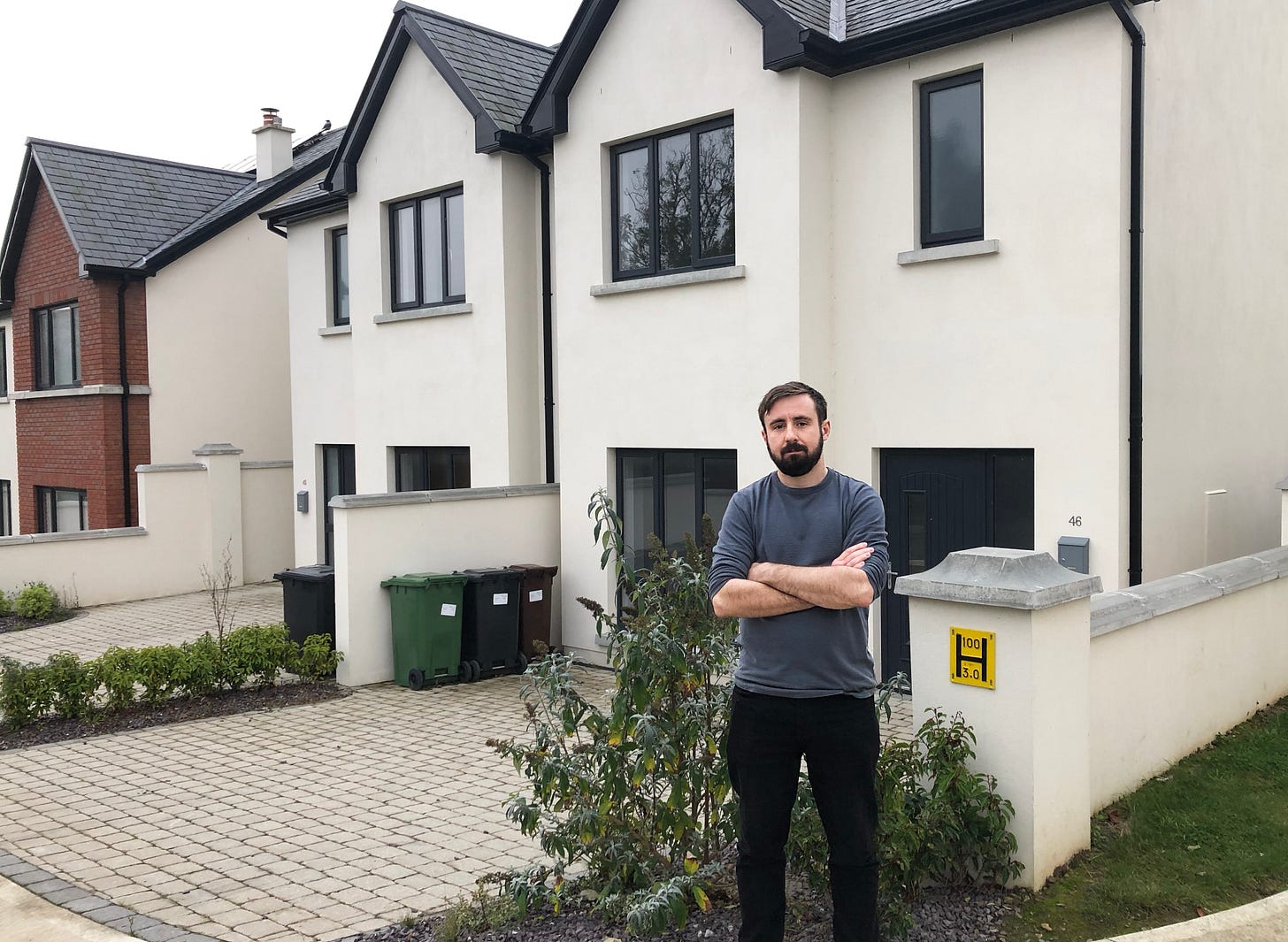
The neighbour
Joshua Copage and his wife are first-time buyers who moved into their home at Maple Hill in the Castle Heights development in Carrigaline almost exactly two years ago.
“Carrigaline is a good place for people to buy at the moment,” Joshua says, strolling down the road on the street he lives on. Children are outside playing, although the amount of open green space Cork County Council wanted in the 214 house development was contested by the developers.
Shortly after he moved in, Joshua noticed that six houses on the end of his row were slightly different to the one he and his wife had bought; they had a different finish, no red brick, and smaller floor space.
These are “Part 5” houses; to offset the increase in land value that a developer gains when a land parcel is zoned for housing, part five of the Planning and Development Acts 2000-2021 allows local authorities like Cork County Council to recoup 20% of the existing land value in the form of homes built for social housing, or in compensation.
We walk down to the houses and Joshua points them out: “There are four semi-d units here, and two more on the corner. They’re built differently and they weren’t listed on the plan. I was thinking, no-one here would have an issue with social housing, but why mark it, why have them stand out? And why have them clustered together here instead of just on the end of a row or something? I presume it’s a cost thing because the facing is totally different and they are lower floor space.”
But the thing that really stands out is that they are still empty, although they were fully finished within weeks of Joshua moving in.
“We moved in in October 2020, the week before Halloween, so we’ve been here two years. Within a few weeks of us being here these were finished: the fences were moved back, the doors were locked, and then they were never touched again.”
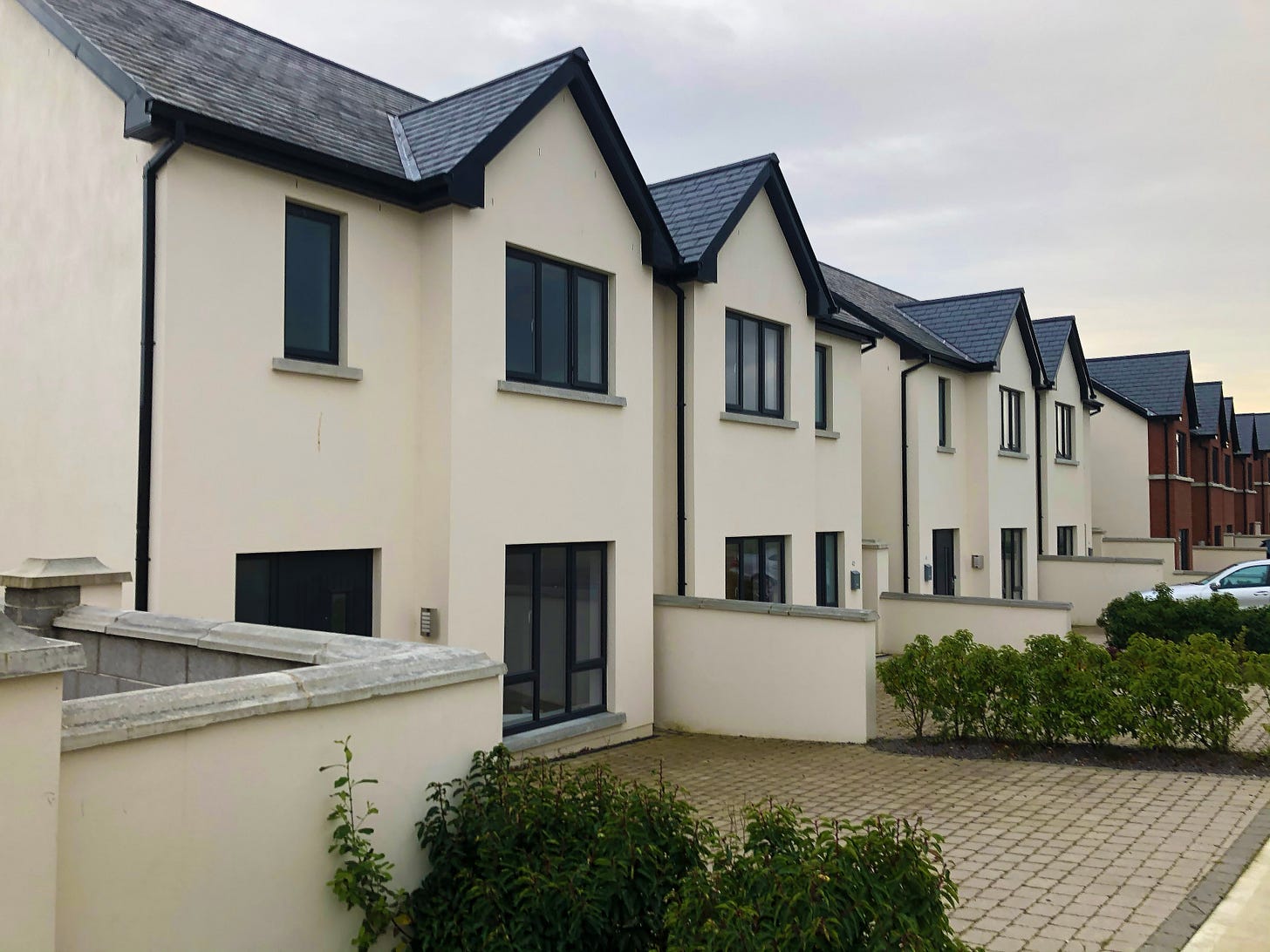
Cork County Council’s press representative tells me that three of the properties “should be tenanted by the end of October. The assessment process is underway for the other three properties and they are expected to be tenanted shortly afterwards.”
Indeed, there is a car in the driveway of one of the houses when we pass: a first, Joshua says. Maybe someone is getting to move in.
The houses were advertised on the Choice Based Letting system in June 2022, the press representative says in his email. So what was the delay, of over a year and a half, between the builders finishing work on them and them being advertised?
“The completion and handover of these properties were delayed as a result of the impacts of Covid,” comes the response.
This simply doesn’t wash with Joshua. “I do not understand how Covid would hold up the process, even if it took one person at a time going into the house,” he says. “Once they’re given the house by the developer, how does Covid stop you from moving in? In the meantime, where have those people been? Living with family, in emergency accommodation?”
“You have to feel for the people who are waiting on the list and whatever they’re going through, the anger and frustration they would feel if they knew that these had been here for two years. Unoccupied, unused, perfectly good houses, brand new, incredible high-spec. There are so many people who need this right now. It’s incredibly frustrating that people in Cork are being failed like that.”
Of course, social housing allocation is a thorny area, not least in Municipal Districts where everyone knows each other: begrudgery levels can run high and councillors are always loath to offend their immediate voter base.
And in some areas of the county, the perception that social housing will result in devaluation of private property alongside is still prevalent, even though the entire design of the Part 5 process is meant to cut through the notion that social housing should be segregated.
For Joshua, nothing could be further from the truth. More than anything, he wants to see the houses in use, to meet his new neighbours. And with any luck, this is just weeks away, although it’s been such a long time coming.
“I don’t know how many times we have to be told by people who study demographics and urban planning that ghettoisation is the worst thing you can possibly do,” Joshua says.
“As far as logistics, you couldn’t have a better location for social housing: good bus route, five minute walk to the village, low-density housing: it’s perfect.”
Perhaps Joshua feels the urgency of the situation so much having recently escaped the private rental market.
“We were renting in Rochestown before this and we knew we needed to get out of the rental market. We were fortunate enough to be able to do that, but a lot of my friends would still be renting. A lot of them, who aren’t on the social housing list, would die for a house like this,” he says, nodding towards the empty house behind him.




